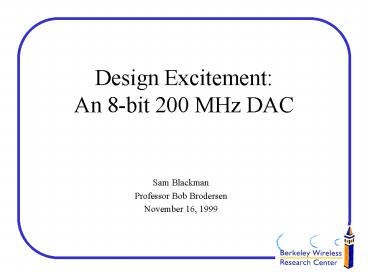Design Excitement: An 8bit 200 MHz DAC - PowerPoint PPT Presentation
1 / 10
Title:
Design Excitement: An 8bit 200 MHz DAC
Description:
Driving cap filter of around 5 pF. Max voltage swing around 2 volts. Thus: This drove design decision of 10 uA of current per source, for a total of 2.56 mA current. ... – PowerPoint PPT presentation
Number of Views:60
Avg rating:3.0/5.0
Title: Design Excitement: An 8bit 200 MHz DAC
1
Design ExcitementAn 8-bit 200 MHz DAC
- Sam Blackman
- Professor Bob Brodersen
- November 16, 1999
2
Goal from Capn Vanderhaegen
- Specifications for DAC determined by SNR
requirements at the receiver. Magic 30 dB - Design tradeoffs speed/resolution of DAC vs.
filter requirement. - In digital domain, pulse shaping filter
complexity increases with DAC speed. Since
digital, can just add more taps. - In analog domain, smoothing filter requirements
decrease with DAC speed. At 200 MHz, only need a
simple one pole RC filter. - System level simulations were performed in MATLAB
to verify functionality.
3
Topology Possibilites 1
- Resistor ladder
- Simple good!
- Poor matching due to low CMOS resistor tolerances
rules it out
- Charge division
- Again, relatively simple
- Low CMOS capacitance tolerances rule it out
- 2N caps large area!
4
Topology Possibilities 2
- Current Division
- Stack of transistors above IREF reduces output
voltage range (Razavi) - Need huge IREF transistor
- No one uses it!
- Current Steering
- Excellent INL/DNL performance (with thermometer
coded input) - Can segment design to save area
- Matching can be controlled to any degree necessary
5
So How Much To Segment?
6
Topology Decision
- 100 Segmented, baby.
- Binary-weighting has many disadvantages
(non-monotonicity, poor linearity) and only one
advantage area savings - For 8-bit accuracy specification, this is not a
factor especially on gigantic pin-limited
testchip. - Limited design time due to unexpected shift in
research emphasis ?
- So now what?
- Key block is the current source cell
- Minimize area since there are 2N!
- How small can transistors be?
- How much current should be sourced?
7
Current Source Design
- Current Sources
- Design considerations have four main factors,
need to optimize - Power
- Matching
- SNR
- Speed
Ian asks Why PMOS based? Cross talk reduction
from digital portions of the chipPMOS devices
built in n-well and thus shielded from the
substrate.
- Power is easy
- Simply number of current sources power dissipated
per source
8
Noise
- Noise
- Top device is main noise source can ignore
cascoded transistor. - Noise power doubled to account for biasing device
and current cell frequency at 30 MHz to account
for worst case (only 12.5 MHz baseband!) - Good to have some margin due to additive coherent
noise from bias, also flicker noise may be
contributing - Simulation matched calculated values extremely
well for one current source. When the entire
design was simulated, however, SNR dropped
substantially. Luckily designed with plenty of
margin!
9
Matching
- Pelgrom 1989 baby
- Each current source controlled by bits of digital
input word, and must have an error lt ½ LSB. No
problem for LSB, but for MSB stringent
requirement - MSB built by wiring up 2N-1 current sources in
parallel, and can then approx. INL by adding
variances. Need INL to be less than ½. - Now need to solve for acceptable standard
deviation for unit current source. Can get rough
estimation by solving p(INLlt1/2 LSB), but Bastos
performed a Monte Carlo simulation to calculate
more accurate figure. This corresponds to a yield
of 99. - Finally can solve for (WL)min using Pelgroms
formula -- A?, AVT, VGS, and VT are process
parameters, I is the current generated by a given
source and ?I is the relative standard deviation
of one current source. So what does this tell us?
For ST matching numbers, minimum WL 2 um2. No
problem!
10
Speed
- DAC has to run at 200 MHz.
- Simple speed estimation
- Driving cap filter of around 5 pF
- Max voltage swing around 2 volts.
- Thus
- This drove design decision of 10 uA of current
per source, for a total of 2.56 mA current. - Simulated fine with 10 pF of load cap.
The Vengabus is coming, and everybodys jumping































